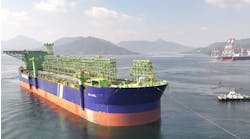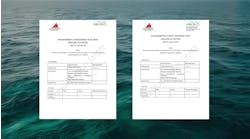New LWD technology mitigates risk from elevated borehole temperatures
Torolf Christensen, Bengt K. Pedersen - Statoil
Alexis Darquin, Graham Raeper - Schlumberger
Elevated borehole temperatures have always hindered logging-while-drilling (LWD) toolstrings. The reason, in a nutshell, is time. No matter how tough they are built, few electronic systems can stand to be heat-soaked for the time it takes to drill a well in hot hole country. Most LWD components carry a maximum temperature rating of 150°C (300°F). Even so, there are many who argue that few of the systems can withstand that temperature for very long. The chance of temperature related downhole tool failures is proportional to the exposure time in addition to the maximum temperature ratings, and the margin between these ratings and the effective operational temperatures.
Wireline versus pipe
When bottomhole temperatures approach 150°C (300°F), operators start looking for alternatives. Many hostile environment wireline tools are rated to 260°C (500°F), and most of the time they are suitable for the task, because few wells are drilled to these temperatures. Wireline tools can solve the time problem by getting to bottom quickly and acquiring data in short order, with encapsulation techniques used to protect tool electronics from full exposure to downhole temperatures for limited periods of time.
Complications arise when formation evaluation acquisition is required in high angle wells. Experience proves that temperatures observed are increased due to well borehole friction compared to vertical offset wells in the same geology. Additionally, wireline operations using pipe conveyance reduces the effectiveness of encapsulating wireline tools due to increased time in the downhole environment.
One advantage of LWD tools is the fact that they can “see” formations before they have been altered by drilling processes such as invasion of mud filtrate and the ability to provide real-time data to optimize well trajectories or subsequent design. These attributes are a dilemma for most operators today.
Statoil has characterized its Kristin field as a tough challenge, and with good reason. The field, on the outer reaches of the Halten Terrace, just below the Arctic Circle and 240 km (150 mi) off the Norwegian coast, meets all the criteria to be classified as an HP/HT (high pressure/high temperature) reservoir with pressures in excess of 900 bar (13,000 psi) and operating temperature above 170°C (338°F). In addition, there is a very narrow window between the pore pressure and fracture pressure gradients. But notwithstanding the challenges, Kristin’s prize created a powerful incentive. Discovered by Saga Petroleum in 1996, and taken over by Statoil for development in 2000, Kristin has three separate, high quality gas reservoirs located between 14,800 ft and 16,400 ft (4,500 m and 5,000 m). Water depth ranges from 1,148 ft to 1,215 ft (350 m to 370 m) which requires development drilling by two semisubmersible drilling units, theScarabeo 5 and the West Alpha.
Statoil has set up an operation support center (OSC) in its offices onshore with assistance from Schlumberger. The OSC allows a concentration of operator and service company expertise to oversee and monitor drilling and completion operations in real-time around the clock.
The dilemma
For about five years, Statoil had been perfecting its drilling techniques for HP/HT reservoirs in the Kristin, Kvitebjørn, and Huldra fields, amassing a record of 15 HP/HT drilling operations and 20 HP/HT completion operations without a single well control incident.
The pressure conditions on Kristin limit the application of wireline logging in highly deviated boreholes with currently available pipe conveyance equipment. In particular, the side entry sub pressure specifications are insufficient to meet requirements for well control. Therefore, from the planning phase of the Kristin project the strategy has been to favor LWD acquisition in high angle wells because of limited operational impact and improved data quality compared to acquisition in reaming passes.
Kristin’s 8 1/2-in. (216-mm) reservoir drilling section, featuring circulating temperature up to 165°C (329°F) has hampered the initial LWD strategy in high deviated wells, because standard 150°C (300°F) rated LWD systems could not withstand Kristin’s bottomhole temperature for an extended time. Hence the dilemma - Kristin’s highly deviated wells presented a situation too hot for standard LWD evaluation and too restricting for wireline.
Tool solution
The solution was EcoScope. This tool is a multifunction LWD formation evaluation device contained in a 7.9-m (26-ft) drill collar that generates formation evaluation and drilling optimization measurements. It generates simultaneous natural gamma ray image, azimuthal lithodensity image, neutron porosity, photoelectric factor, formation sigma, elemental capture spectroscopy (ECS), multifrequency and spacing propagation resistivity, ultrasonic caliper, four axis shocks, near bit inclination, equivalent circulating, and static density measurements. In addition, it is suitable for high temperature operation.
The tool is not powered by batteries, a traditional source of heat-related problems, but by a companion high-speed telemetry-while-drilling tool that generates system electrical power using a mud turbine. The companion telemetry electronics are near the center of the collar, away from the outer shell where heat can build up, closer to the cooling effect of the internal mud flow. The difference can be significant. Internal sensors have measured temperatures 15°C (59°F) degrees lower at the TeleScope electronic circuit boards than in the wellbore annulus or collar mounted electronics. Similar configuration advantage was used on Kristin for formation pressure evaluation.
Service technicians upgraded key components of the tool by incorporating a different potting material with a lower heat transfer coefficient to increase temperature specifications. Alternate technologies relied on lower temperature-rated systems which had very limited life in Kristin’s drilling conditions.
Integrated design
Additionally, the tool’s integrated design provided an advantage in this environment by improving operational efficiency relative to BHA handling on the rig while minimizing rat hole requirements to reduce drilling time.
The tool behavior in the high temperature environment initially was tested on two reservoir sections. Five runs were performed; where the tool was used while drilling, totaling more than 450 hr downhole. Circulating temperature was above 160°C (320°F) during these sections with no temperature related failure, proving the tool capable of withstanding the severe downhole conditions. The tool was used for the remaining four highly deviated wells to provide formation LWD.
The tool’s ability to deliver formation sigma and element capture spectroscopy was evaluated to provide further answers in complex lithology or mud system disturbing interpretation process. Similarly, these operations provided the opportunity to evaluate the tool’s potential for delivering density and neutron measurement without any chemical source in the BHA. The neutron-based density estimate showed promise where drilling runs are required, although the best density measurement is obtained by including the density source.
Combining measurements and the upgraded components allowed the evaluation of the middle Jurassic sandstones of the Garn, Ile, and Tofte formations within the 5,000 m (16,400 ft) TVD, and 2,000 m (6,560 ft) horizontal displacement for a TMD of 6,500 m (21,320 ft) wellbore. Reserves in the field are officially estimated at 29 bcm (1,024 bcf) of dry gas, 6.3 million tons of natural gas liquid and 34 MMcm (1.2 bcf) of condensate.
The original LWD data acquisition strategy for highly deviated wells while drilling can be achieved without excess trips from tool failures. Minimizing trips results in reduced hole degradation providing a better environment for improved measurement quality and less problems completing the wells.





